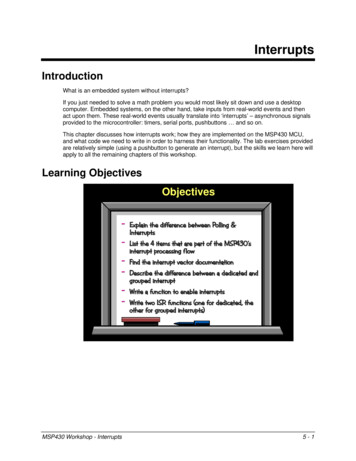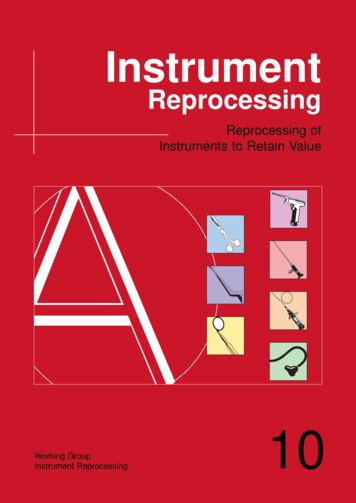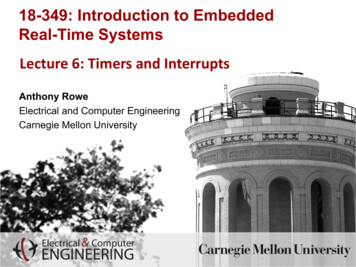
Transcription
InterruptsIntroductionWhat is an embedded system without interrupts?If you just needed to solve a math problem you would most likely sit down and use a desktopcomputer. Embedded systems, on the other hand, take inputs from real-world events and thenact upon them. These real-world events usually translate into ‘interrupts’ – asynchronous signalsprovided to the microcontroller: timers, serial ports, pushbuttons and so on.This chapter discusses how interrupts work; how they are implemented on the MSP430 MCU,and what code we need to write in order to harness their functionality. The lab exercises providedare relatively simple (using a pushbutton to generate an interrupt), but the skills we learn here willapply to all the remaining chapters of this workshop.Learning ObjectivesObjectives- Explain the difference between Polling &Interrupts- List the 4 items that are part of the MSP430’sinterrupt processing flow- Find the interrupt vector documentation- Describe the difference between a dedicated andgrouped interrupt- Write a function to enable interrupts- Write two ISR functions (one for dedicated, theother for grouped interrupts)MSP430 Workshop - Interrupts5-1
Interrupts, The Big PictureChapter TopicsInterrupts . 5-1Interrupts, The Big Picture . 5-3Polling vs Interrupts. 5-3Processor States and Interrupts . 5-5Threads: Foreground and Background . 5-6How Interrupts Work . 5-71. Interrupt Must Occur . 5-92. Interrupt is Flagged (and must be Enabled) . 5-103. CPU's Hardware Response . 5-124. Your Software ISR . 5-14Interrupts: Priorities & Vectors . 5-17Interrupts and Priorities . 5-17Interrupt Vector (IV) Registers . 5-18Interrupt Vector Table . 5-19Coding Interrupts. 5-22Dedicated ISR (Interrupt Service Routine). 5-22Grouped ISR (Interrupt Service Routine) . 5-24Enabling Interrupts . 5-26Miscellaneous Topics . 5-28Handling Unused Interrupts . 5-28Interrupt Service Routines – Coding Suggestions . 5-29GPIO Interrupt Summary . 5-30Interrupt Processing Flow . 5-30Interrupts and TI-RTOS Scheduling. 5-31Threads – Foreground and Background . 5-31TI-RTOS Thread Types. 5-33Summary: TI-RTOS Kernel . 5-36Lab Exercise . 5-375-2MSP430 Workshop - Interrupts
Interrupts, The Big PictureInterrupts, The Big PictureWhile many of you are already familiar with interrupts, they are so fundamental to embeddedsystems that we wanted to briefly describe what they are all about.From Wikipedia:A hardware interrupt is an electronic alerting signal sent to the processor from an external device,either a part of the [device, such as an internal peripheral] or an external peripheral.In other words, the interrupt is a signal which notifies the CPU that an event has occurred. If theinterrupt is configured, the CPU will respond to it immediately – as described later in this chapter.Polling vs InterruptsIn reality, though, there are two methods that events can be recognized by the processor. One iscalled “Polling”; the other is what we just defined, “Interrupts”.We start with a non-engineering analogy for these two methods. If you’ve ever taken a long familyvacation, you’ve probably dealt with the “Are we there yet” question. In fact, kids often ask it overand-over again. Eventually the answer will be, “Yes, we’re there”. The alternative method iswhen my spouse says, “Wake me up when we get there”.Waiting for an Event: Famfiv VacatfonPoooingInterruptsWane me up when we get there.Both methods signal that we have arrived at our destination. In most cases, though, the use ofInterrupts tends to be much more efficient. For example, in the case of the MSP430, we oftenwant to sleep the processor while waiting for an event. When the event happens and signals uswith an interrupt, we can wake up, handle the event and then return to sleep waiting for the nextevent.MSP430 Workshop - Interrupts5-3
Interrupts, The Big PictureA real-world event might be our system responding to a push-button. Once again, the event couldbe handled using either Polling or Interrupts.It is common to see “simple” example code utilize Polling. As you can see from the left-sideexample below, this can simply consist of a while{} loop that keeps repeating until a button-pushis detected. The big downfall here, though, is that the processor is constantly running– asking thequestion, “Has the button been pushed, yet?”Waiting for an Event: Button PushPollingwhile(1) {Interrupts// GPIO button interrupt// Polling GPIO button#pragma vector PORT1 VECTORwhile (GPIO getInputPinValue() 1)interrupt void rx (void){GPIO toggleOutputOnPin();GPIO toggleOutputOnPin();}}100% CPU Load 0.1% CPU LoadThe example on the right shows an Interrupt based solution. Since this code is not constantlyrunning, as in the previous example’s while{} loop, the CPU load is very low.Why do simple examples often ignore the use of interrupts? Because they are “simple”.Interrupts, on the other hand, require an extra three items to get them running. We show two ofthem in the right-hand example above. The #pragma sets up the interrupt vector. The MSP430 has a handy pragma which makes iteasy to configure this item. (Note: we’ll cover the details of all these items later in thischapter.) The interrupt keyword tells the compiler to code this function as an interrupt service routine(ISR). Interrupt functions require a context save and restore of any resources used withinthem.While not shown above, we thought we’d mention the third item needed to get interrupts to work.For a CPU to respond to an interrupt, you also need to enable the interrupt. (Oh, and you mayalso have to setup the interrupt source; for example, we would have to configure our GPIO pin tobe used as an interrupt input.)So, in this chapter we leave the simple and inefficient examples behind and move to the realworld – where real-world embedded systems thrive on interrupts.5-4MSP430 Workshop - Interrupts
Interrupts, The Big PictureProcessor States and InterruptsIn a previous chapter we covered many of the MSP430’s processor states. To summarize, theMSP430 CPU can reside in: Reset, Active, or one of many Low-Power Modes (LPM). In manycases, interrupts cause the CPU to change states. For example, when sitting in Low PowerMode, an interrupt can “wake-up” the processor and return it to its active mode.To help demonstrate this point, we stole the following slide from a discussion about CapacitiveTouch. While most of this slide’s content is not important for our current topic, we thought thecurrent vs time graph was interesting. It tries to visually demonstrate the changing states of thedevice by charting power usage over time.Notice the four states shown in this diagram: Notice how the current usage goes up at the beginning event – this is when the CPU iswoken up so it can start a couple of peripherals (timers) needed to read the CapTouchbutton. The CPU can then go back to sleep while the sensor is being ‘read’ by the timers. When the read is complete (defined by something called “Gate” time, the CPU getsinterrupted and wakes up again in order to calculate the CapTouch button’s value from thesensor data. Finally the CPU (and CapTouch hardware) can go back to sleep and wait for another systemwake-up event.Interrupts Help Support Ultra Low PowerVery little CPUeffort required Keep CtU asleep (i.e. in Lowtower aode) while waiting forevent Lnterrupt ‘wakes up’ CtU whenit’s required Only timers are running Another way to look at it isthat interrupts often cause aprogram state changeOften, work can be done byperipherals, letting CtU stay inLta (e.g. Gate Time)Lots of sleep timeMSP430 Workshop - Interrupts5-5
Interrupts, The Big PictureThreads: Foreground and BackgroundWe conclude our Interrupts introduction by defining a few common terms used in interrupt-drivensystems: Thread, Foreground and Background.If you look at the “code” below, you will see that there are three individual – and independent –code segments below: main, ISR1, and ISR2.We use the word independent because, if you were to examine the code in such a system, thereare no calls between these three routines. Each one begins and ends execution without callingthe others. It is common to call these separate segments of code: “Threads”.Foreground / Background Schedulingmain() or LPax}}ISR1geP daPaprocessISR2seP a flag{ystem Initialization The beginning part of main() is usually dedicatedto setting up your system (/hapters 3 and 4).ackgroundaost systems have an endless loop that runs‘forever’ in the background In this case, ‘.ackground’ implies that it runs at alower priority than ‘Coreground’ In a{P430 systems, the background loop oftencontains a Low Power aode (LPax) command –this sleeps the /PU/{ystem until an interruptevent wakes it up Coreground Interrupt {ervice woutine (I{w) runs in responseto enabled hardware interrupt These events may change modes in .ackground –such as waking the /PU out of low-power mode I{w’s, by default, are not interruptible {ome processing may be done in I{w, but it’susually best to keep them shortAs we’ve seen in the workshop already, it is our main() thread that begins running once the processor hasbeen started. The compiler’s initialization routine calls main() when its work is done. (In fact, this is why all Cprograms start with a main() function. Every compiler works the same way, in this regard.)With the main() thread started, since it is coded with a while(1) loop, it will keep running forever. That is,unless a hardware interrupt occurs.When an enabled interrupt is received by the CPU, it preempts the main() thread and runs the associatedISR routine – for example, ISR1. In other words, the CPU stops running main() temporarily and runs ISR1;when ISR1 completes execution, the CPU goes back to running main().5-6MSP430 Workshop - Interrupts
How Interrupts WorkHere’s where the terms Foreground and Background come into play. We call main() the Backgroundthread since it is our “default” thread; that is, the program is designed such that we start running main() andgo back to it whenever we’re done with our other threads, such as ISR1.Whenever an interrupt causes another thread to run,we call that a Foreground thread. The foregroundthreads preempt the Background thread, returning tothe Background once completed.The words “Foreground” and “Background” aren’tterribly important. They just try to provide a bit of context that can be visualized in this common way.It should be noted that it’s important to keep your interrupt service routines short and quick. This, again, iscommon practice for embedded systems.Note:We realize that our earlier definition of “Thread” was a little weak. What we said was true, but not complete. Theauthor’s favorite definition for “Thread” is as follows:“A function or set of functions that operate independently of other code – running within their own context.”The key addtion here is that a thread runs within its own context. When switching from one thread to another, thecontext (register values and other resources) must be saved and restored.How Interrupts WorkNow that we have a rough understanding of what interrupts are used for, let’s discuss whatmechanics are needed to make them work. Hint, there are 4 steps to getting interrupts to work How do Interrupts Work?Slide left intentionally blank If you’ve been reading this chapter, you might notice that we’ve already covered these four items.Over the next few pages we enumerate these steps again, filling-in additional details.MSP430 Workshop - Interrupts5-7
How Interrupts WorkNotes5-8MSP430 Workshop - Interrupts
How Interrupts Work1. Interrupt Must OccurFor the processor to respond to an interrupt, it must have occurred. There are many possiblesources of interrupts. Later in this chapter we will delve into the MSP430 datasheet which lists allof the interrupt sources.How do Interrupts Work?1. An interrupt occurs currently executing codeinterrupt occurs UAwTGtIOTimersADCEtc.next line of code}Suffice it to say that most peripherals can generate interrupts to provide status and information tothe CPU. Most often, the interrupt indicates that data is available (e.g. serial port) and/or an eventhas occurred that needs processing (e.g. timer). In some cases, though, an interrupt may be usedto indicate an error or exception in a peripheral that the CPU needs to handle.Interrupts can also be generated from GPIO pins. This is how an external peripheral, or someother controller, can signal the MSP430 CPU. Most MSP430 devices allow the pins from the firsttwo I/O ports (P1 and P2) to be individually configured for interrupt inputs. On the larger devices,there may be additional ports that can be configured for this, as well.Finally, your software can often generate interrupts. The logic for some interrupts on theprocessor allow you to manually set a flag bit, thus ‘emulating’ a hardware interrupt. Not allinterrupts provide this feature, but when available, it can be a handy way to test your interruptservice routine.MSP430 Workshop - Interrupts5-9
How Interrupts Work2. Interrupt is Flagged (and must be Enabled)When an interrupt signal is received, an interrupt flag (IFG) bit is latched. You can think of this asthe processor’s “copy” of the signal. As some interrupt sources are only on for a short duration, itis important that the CPU registers the interrupt signal internally.How do Interrupts Work?1. An interrupt occurs currently executing codeinterrupt occurs UAwTGtIOTimersADCEtc.next line of code}2. It sets a flag bitin a register.MSP430 devices are designed with “distributed” interrupt management. That is, most IFG bits arefound inside each peripheral’s control registers; this is different from most processors which havea common, dedicated set of interrupt registers.The distributed nature of the interrupts provides a number of benefits in terms of device flexibilityand future feature expansion; further, it fits nicely with the low-power nature of the MSP430.The only ‘negative’ of distributed interrupts might be that it’s different — it’s just that many of usolder engineers are used to seeing all the interrupts grouped together. Bottom line, though, is thatworking with interrupts (enabling interrupts, clearing flags, responding to them) is the samewhether the hardware is laid out centrally or in a distributed fashion.5 - 10MSP430 Workshop - Interrupts
How Interrupts WorkInterrupt FlowHow does the interrupt signal reach the CPU?We’ve just talked about the interrupt flag (IFG) bit – let’s start there. As described on the previous page,when the interrupt source signal is received, the associated IFG bit is set. In fact, DriverLib containsfunctions to read the status of most IFG bits. (Handy in those few cases where you need to poll an interruptsource.)When the IFG is set, the MSP430 device now sees that the signal has occurred, but the signal hasn’t madeits way to the CPU, yet. For that to happen, the interrupt must be enabled.Interrupt FlowInterruptSourceIFG bitIE bitInterrupt‘Flag’“Individual”Int EnableGPIO0TIMER A1 0NMI0SR.GIE“Global”Int EnableFPUInterrupt Flag weg (IFw)bit set when int occurs; e.g.GPIO getInterruptStatus();GPIO clearInterruptFlag();Interrupt Enable (IE); e.g.GPIO enableInterrupt();GPIO disableInterrupt();TIMER A enableInterrupt();Global Interrupt Enable (GIE)Enables ALL maskable interruptsEnable: bis SR register( GIE );Disable: bic SR register( GIE );Interrupt enable bits (IE) exist to protect the CPU and thus, your program. Even with so many peripheralsand interrupt sources, it’s likely that your program will only care about a few of them. The enable bits provideyour program with ‘switches’ that let you ignore all those sources you don’t need.By default, all interrupt bits are disabled (except the Watchdog Timer). It is your program’s responsibility toenable those interrupt sources that are needed. To that end, once again, DriverLib provides a set offunctions that make it easy for you to set the necessary IE bits.Finally, there’s a “master” switch that turns all interrupts off. This lets you turn off interrupts without having tomodify all of the individual IE bits. The MSP430 calls this the global interrupt enable (GIE). It is found in theMSP430 Status Register (SR).Why would you need a GIE bit? Sometimes your program may need to complete some code atomically; thatis, your program may need to complete a section of code without the fear that an interrupt could preempt it.For example, if your program shares a global variable between two threads – say between main() and anISR – it may be important to prevent interrupts while the main code reads and modifies that variable.Note:There are a few non-maskable interrupts (NMI). These sources bypass the GIE bit. Theseinterrupts are often considered critical events – i.e. ‘fatal’ events – that could be used to provide awarm reset of the CPU.MSP430 Workshop - Interrupts5 - 11
How Interrupts Work3. CPU's Hardware ResponseAt this point, let’s assume you have an interrupt that has: occurred; been flagged; and since itwas enabled, its signal has reached the CPU. What would the CPU do in response to theinterrupt?Earlier in the chapter we stated: “The interrupt preempts the current thread and starts running theinterrupt service routine (ISR).” While this is true, there are actually a number of items performedby the hardware to make this happen – as shown below:How do Interrupts Work?1. An interrupt occurs currently executing codeinterrupt occurs UAwTGtIOTimersADCEtc.next line of code}3. CtU acknowledges INT by Current instruction completesSaves return-to location on stackSaves ‘Status weg’ (Sw) to the stackClears most of Sw, which turns offinterrupts globally (Sw.GIE 0) Determines INT source (or group) Clears non-grouped flag* (IFG 0) weads interrupt vector & calls ISw2. Sets a flag bit(IFG) in register.We hope the first 3 items are self-explanatory; the current instruction is completed while theProgram Counter (PC) and Status Register (SR) are written to the system stack. (You mightremember, the stack was setup for the MSP430 by the compiler’s initialization routine. Pleaserefer to the compiler user’s guide for more information.)After saving the context of SR, the interrupt hardware in the CPU clears most of the SR bits. Mostsignificantly, it clears GIE. That means that by default, whenever you enter an ISR function, allmaskable interrupts have been turned off. (We’ll address the topic of ‘nesting’ interrupts in thenext section.)The final 3 items basically tell us that the processor figures out which interrupt occurred and callsthe associated interrupt service routine; it also clears the interrupt flag bit (if it’s a dedicatedinterrupt). The processor knows which ISR to run because each interrupt (IFG) is associated withan ISR function via a look-up table – called the Interrupt Vector Table.5 - 12MSP430 Workshop - Interrupts
How Interrupts WorkInterrupt Vector Table – How is it different than other MCU’s?The MSP430 Vector Table is similar and dissimilar to other microcontrollers: The MSP430, like most microcontrollers, uses an Interrupt Vector Table. This is an areaof memory that specifies a vector (i.e. ISR address) for each interrupt source. Some processors provide a unique ISR (and thus, vector) for every interrupt source.Other processors provide only 1 interrupt vector and make the user program figure whichinterrupt occurred. To maximize flexibility and minimize cost and power, the MSP430 fallsin between these two extremes. There are some interrupts which have their own,dedicated interrupt vector – while other interrupts are logically grouped together. Where the MSP430 differs from many other processors is that it includes an InterruptVector (IV) register for each grouped interrupt; reading this register returns the highestpriority, enabled interrupt for that group of interrupt sources. As we’ll see later in thischapter, all you need to do is read this register to quickly determine which specificinterrupt to handle.Note:We’ll describe Interrupt Vector Table in more detail later in the chapter.MSP430 Workshop - Interrupts5 - 13
How Interrupts Work4. Your Software ISRAn interrupt service routine (ISR), also called an interrupt handler, is the code you write that willbe run when a hardware interrupt occurs. Your ISR code must perform whatever task you want toexecute in response to the interrupt, but without adversely affecting the threads (i.e. code)already running in the system.Before we examine the details of the ISR; once again, how did we get to this point?Looking at the diagram below, we can see that (1) the interrupt must have occurred; (2) the processorflags the incoming interrupt; (3) if enabled, the interrupt flag signal is routed to the CPU where it savesthe Status Register and Return-to address and then branches to the ISR’s address found in theappropriate location in the vector table. (4) Finally, your ISR is executed.How do Interrupts Work?1. An interruptoccurs UAwTGtIOTimersA/D ConverterEtc.2. Sets a flag bit(IFG) in register.3. CtU acknowledges INT by Current instruction completesSaves return-to location on stackSaves ‘Status weg’ (Sw) to the stackClears most of Sw, which turns offinterrupts globally (Sw.GIE 0) Determines INT source (or group) Clears non-grouped flag* (IFG 0) weads interrupt vector & calls ISw4. ISw (Interrupt Service woutine) Save context of system (optional) we-enable interrupts *If group INT, read IV weg todetermines source & clear IFG wun your interrupt’s code westore context of system Continue where it left off (wETI)The crux of the ISR is doing what needs to be done in response to the interrupt; the 4th bullet(listed in red) reads: Run your interrupt’s codeThis is meant to describe the code you write to handle the interrupt. For example, if it’s a UARTinterrupt, your code might read an incoming byte of data and write it to memory.We’ll discuss the 2nd (optional) bullet on the next page.The 3rd bullet indicates that if this is a “grouped” interrupt, you have to add code to figure outwhich interrupt, in the group, needs to be handled. This is usually done by reading the group’s IVregister. (This bullet was in red because it is code you need to write.)The other bullets listed under “4. ISR” are related to saving and restoring the context of thesystem. This is required so that the condition mentioned earlier can be met: “without adverselyaffecting the code threads already running in the system.”5 - 14MSP430 Workshop - Interrupts
How Interrupts WorkWe show the interrupt flow in a slightly different fashion in the following diagram. As you can see,when an enabled interrupt occurs, the processor will look up the ISR’s branch-to address from aspecific address in memory (called the interrupt vector). For the MSP430, this address is definedusing the vector pragma.4. Interrupt Service Routine (ISR) currently executing codeinterrupt occursVector Table&myISRnext line of code}Using Interrupt Keyword Compiler handles context save/restore Call a function? Then full context is saved No arguments, no return values You cannot call any TI-RTO{ schedulerfunctions (e.g. {wi post) Nesting interrupts is aANUAL#pragma vector WDT VECTORinterrupt myISR(void){ {ave context of system (optional) Re-enable interrupts *If group INT, read assoc IV Reg(determines source & clears ICD) Run your interrupt’s code Restore context of system Continue where it left off (RETI)}The context of the system – for example, the CPU registers used by the ISR – must be savedbefore running your code and restored afterwards. Thankfully, the compiler handles this for youwhen the function is declared as an interrupt. (As part of the “context restore”, the compiler willreturn to running the previous thread of code by using the RETI instruction).Please note the bullets under “Using the Interrupt Keyword” from the preceding diagram.Using this keyword, the compiler handles all of the context save/restore for you and knows how toreturn to your previous code – even restoring the original value for the Status Register (SR).Hint:If you call a function within your ISR, the compiler will have to save/restore every CPUregister, not just the ones that it uses to implement your C code. This is because itdoesn’t know what resources the function call may end up using.Since the interrupt occurs asynchronously to the background thread, you cannot pass argumentsto and receive return values from the ISR. You must communicate between threads using globalvariables (or other appropriate data objects).TI’s real-time operating system (TI-RTOS) provides a rich set of scheduling functions that areoften used within interrupt service routines. Be aware, though, that some of these functions canonly be used with RTOS “managed” interrupts. In fact, it’s actually easier to let TI-RTOS manageyour interrupts; it automatically handles plugging the interrupt vector as well as contextsave/restore. (All you have to do is write a standard C function.) But, the details of TI-RTOS areoutside the scope of this workshop. While we provide a brief discussion of TI-RTOS at the end ofthis chapter, please refer to the Introduction to TI-RTOS Kernel workshop for more details.MSP430 Workshop - Interrupts5 - 15
How Interrupts WorkNesting Interrupts (not recommended)Finally, while the MSP430 allows nesting of interrupts, it is not recommended. Nesting interrupts means one interrupt can interrupt another interrupt. You must manually configure nesting. That is, before running your interrupt handling codeyou must: Disable any interrupts that you do not want to occur during your ISR. In other words, youmust first save, then disable, any IE bit that correlates to an interrupt that you do not wantto interrupt your ISR. Then, turn on interrupts globally by setting GIE 1. At this point you can run your code that responds to the original interrupt. It may end upbeing interrupted by any source that you left enabled. When you’ve completed your original interrupt code, you need to disable interrupts beforereturning from the function. That is, set GIE 0. (This is the state GIE was in whenentering your ISR code. You can now restore the IE bits that you saved before enabling GIE. At this point, you can return from the ISR and let the compiler’s code handle theremaining context save and return branch back to the original thread.In general, it’s considered better programming practice to keep interrupt service routines veryshort – i.e. lean-and-mean. Taking this further, with low-power and efficiency in mind, theMSP430 team recommends you follow the no-nesting general principle.Hint:5 - 16We encourage you to avoid nesting, if at all possible. Not only is it difficult, and errorprone, it often complicates your programs ability to reach low-power modes.MSP430 Workshop - Interrupts
Interrupts: Priorities & VectorsInterrupts: Priorities & VectorsInterrupts and PrioritiesEach MSP430 device datasheet defines the pending priority for each of its hardware interrupts. Inthe case of the MSP430F5529, there are 23 interrupts shown listed below in decreasing priority.In the previous paragraph we used the phrase “pending priority” deliberatel
Summary: TI-RTOS Kernel . 5-36Lab Exercise . 5-37 5 - 2 MSP430 Workshop - Interrupts . Interrupts, The Big Picture Interrupts, The Big Picture . While many of you are already familiar with interrupts, they are so fundamental to embedded systems that we wanted to briefly describe what they are all about. .










